 | 1.
Palmerston Atoll (August / September 2007)| After a pleasant enough 4 day sail from Bora Bora the Palmerston Atoll made its appearance on schedule on the horizon and as we closed land so we were contacted by Simon, our host for our time on Palmerston. It was an amazing experience: Palmerston Island is populated by the descendants of William Marsters who arrived here in 1777 (three years after Cook discovered the place), took 3 wives and got to work. Eddie and Simon Marsters were our hosts, taking us to and from shore each day (the pass through the reef was not do-able by dinghy), feeding us lunch and making sure we did not contact either of the other two families on the island; the three Masters offshoots do not get on well together despite the 70 or so of them sharing a 1 square-mile island. Whilst we were there we rode out a gale in the lee of the island, watched the quarterly supply ship fail to deliver the supplies that it should have loaded on Rarotonga and we made good friends with Bob Marsters and his family, one of the other families! Palmerston was incredible: the locals barely need to lift a finger to exist; they fish intensively for two weeks before each supply ship comes and buy their supplies with the proceeds. Their generator runs twice a day for a few hours to give them light, music and power to run a DVD player and a TV. There is one phone and one computer on the island, these are available sporadically for the locals. It was a totally unique experience for us. |
| 0 Visits
0 Images
Shared Album | |
|
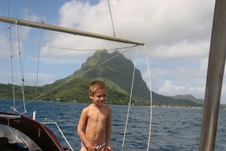 | 2.
Raiatea, Tahaa and Bora Bora (August 2007)The two islands of Raiatea and Tahaa are surrounded by fringing reef and one can cruise round these two beautiful islands without having to leave the reef’s protection. We arrived through a gap in the reef on the SE side of Raiatea after spending a couple of days in Huahine. Raiatea and Tahaa are very picturesque, unspoilt, verdant islands French Polynesia and although Raiatea is the base for charter yachts in Polynesia it was possible to find stunning anchorages away from other boats.
Bora Bora was a real disappointment. We found it awfully built-up and commercialised, geared towards relieving tourists of their cash and areas that would have been picture postcard perfect have been ruined by beach hotels. Habitats for many fish species including large manta rays have been destroyed in the process. We changed the boat’s batteries in Bora Bora and spent a few lovely days in an anchorage tucked away from the bustle ashore. Here we also said a very sad goodbye to Eric and Jeniya on Meta, they had become very good friends since we met them in Cartagena. |
| 10061 Visits
26 Images
Shared Album | |
|
 | 3.
Tahiti and Moorea (July 2007)Tahiti, after the wide-open lagoons and turquoise colours of the Tuamotus, was a shock. Papeete, the capital city of the Society islands, was a mass of roaring traffic and pollution so after spending a couple of pricey nights tied alongside the once busy town quay near the busy road we snuck off round the corner and once again found beauty, peace and quiet and those lovely turquoise anchorages. Being a part of France we had good access to a Carrefour Supermarche which was heaven, almost literally, after having no real access to decent food shops since February! Fresh French bread, brie and wine: bliss. Oh, but you pay about double the supermarket prices in the UK.
From Tahiti we sailed to Moorea, an absolutely stunning island, which we were expecting to be overrun by tourists: not so. Our first anchorage on the east side of the island was deserted and we anchored in water so clear that we could see our anchor and chain on the sand in the moonlight. We spent subsequent days in Cook’s Bay and Oponahu Bay where we again found total solitude and scenery that is simply stunning. In Moorea I did three dives beyond the protective reef that surrounds the island, diving with Black-tip and Lemon sharks amongst pristine coral; I even saw clown fish (you know, Nemo) hiding in an anemone, a long term want for me. As a family we swam amongst sting-rays that would literally eat out of your hand! With the people being amongst the friendliest we have ever met we loved Moorea. |
| 31517 Visits
53 Images
Gallery Album | |
|
 | 4.
The Tuamotus (July 2007)| 600 miles to the WSW of the Marquesas lie the coral atolls that form the large Tuamotu archipelago. The slow journey took us a week, during which we celebrated my birthday! Atolls are a circle of small islands that form an enclosed lagoon, entered by a pass. The timing in the passes is critical if one is to avoid strong currents are awfully rough seas. We visited 2 atolls. Ahe was a small atoll with one village. After the Marquesas where we constantly rolled at anchor in the exposed bays Ahe was a lovely change. The village was small and the people friendly but we felt that one day was enough here so we sailed on to Rangiroa, the worlds’ 2nd largest atoll. Here I did some spectacular dives into schools of sharks, barracuda, turtles and rays. The water is exceptionally clear. Again the friendliness of the locals was overwhelming, we travelled by hitching lifts and the local storekeeper kept giving us many gifts. |
| 11018 Visits
39 Images
Gallery Album | |
|
 | 5.
The Marquesas (June and July 2007)Les Isles Marquises are the first of the French Polynesian islands on our route through the Pacific. Arriving at Fatu Hiva after 23 days at sea was amazing; the anchorage was stunningly beautiful, and the people ashore gave us our first glimpse at how friendly the Polynesians can be. On Fatu Hiva the small community of 200 people welcomed us and were generous with their hospitality, inviting us to a Fathers’ day celebration after church. In church we became hooked on the Polynesian singing, which has to be heard to be believed.
After Fatu Hiva we sailed north to Hiva Oa, where we cleared in, re-provisioned (French bread and croissants being a real treat) and hired a 4WD car to travel to the north of the island over progressively bad roads to the small village of Puamau where we saw a famous Tiki site (ancient stone statues carved by the first settlers of the islands) and where again we were invited to take part in a local lunch celebration.
From Hiva Oa we sailed south-west to Tahuata and enjoyed 3 anchorages although the swell in each made going ashore a perilous affair. The highlight of the frist anchorage was spending a lazy hour snorkelling with a school of manta rays. Again in the village of Vaitahu we were overwhelmed by the generosity of the locals, and by the beauty of the surroundings. Lovely, lovely islands. |
| 14954 Visits
65 Images
Gallery Album | |
|
 | 6.
Pacific Ocean (May and June 2007)The Pacific Ocean is vast, the world’s largest ocean by a huge margin. To say that we’ve crossed it is overstating the case, but we’ve completed the longest leg across this ocean, from the Galapagos Islands to the Isles Marquises (the Marquesas) in French Polynesia.
We sailed just over 3000 nautical miles in 23 days and experienced a variety of conditions at sea, from flat calms to winds requiring a couple of reefs. On the whole the winds were light and the seas lumpy, which left us often with sails that filled first from one side and then the other with a bang; this is damaging to sails, rig and nerves!
The pictures here are snapshots from our life at sea, which on a 35 foot boat is not always thrilling but these pictures reflect the timeless life that is passage-making. |
| 42144 Visits
64 Images
Gallery Album | |
|
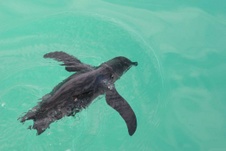 | 7.
Galapagos 2 (May 2007)| From San Cristobal we motored, nursing a failing water pump on the engine, to Santa Cruz, the main centre in the islands. Here we have divided our time between walking to local beaches across arid, cactus strewn landscapes and trying to arrange for the shipment and fitting of water pump parts. We’ve also seen tortoises in the wild here and been underground in lava tubes, tunnels formed by lava from the volcanoes that have formed these islands. From here we move to the very tranquil island of Isabela. Here, whilst not helping boats that have dragged onto the beach, we took a horseback trip up a volcano that erupted in the late 70’s to see tremendous lavascapes and more locally to the anchorage we saw the endemic penguins and some white-tip sharks. Isabela was a beautiful, peaceful place from which to prepare for our Pacific crossing, but we left the Galapagos with very happy memories of these very special wildlife-rich islands. |
| 13704 Visits
57 Images
Gallery Album | |
|
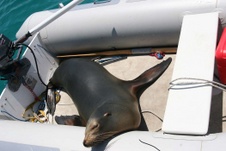 | 8.
Galapagos 1 (April and May 2007)| Our trip from mainland Ecuador to the Galapagos islands was beset by little wind, and we had to motor for 2½ days of the 5 that we were at sea to cover the 600 miles to these remote, amazing islands. Yachts are generally not encouraged to stay and are usually only granted permission to stay 10 days or so on one island only. Having hired an agent through whom we arranged a cruising permit we enjoy more freedom and have visited the three main islands. San Cristobal, our first island, had a beautiful calm anchorage with hundreds of sea-lions swimming around, and lounging around on the decks of the local fishing boats. On this island we took a tour to see some of the famous Galapagos tortoises in a nature reserve and some marine iguanas on a local beach. We also took a boat trip to the west side of the island where, whilst diving and snorkelling we swam with sharks and rays, and later swam with a huge turtle and a very playful and inquisitive group of sea-lions who would swim right up to you, blow a jet of bubbles and race off! |
| 20285 Visits
95 Images
Gallery Album | |
|
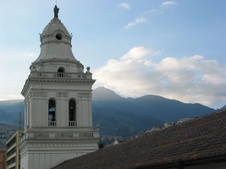 | 9.
Inland Ecuador (March 2007)| Whilst work progressed on Clarabella we went travelling the length of Ecuador. Transport on buses was excellent and cheap throughout and our travels took us first to the northern Andean towns which have specialist craft markets. Quito, the capital, was superb, the old town was crammed with superb old churches and colonial architecture. We moved south through the tourist-centred town of Banos down to the most important Inca sun temple after Machu Pichu. The Ecuadorian people are unfailingly friendly and helpful, and we particularly enjoyed seeing the native Indians, but we must push on now and the Galapagos Islands beckon. |
| 55399 Visits
147 Images
Shared Album | |
|
 | 10.
Crossing the Line - Panama to Ecuador (March 2007)After we celebrated Rebcca’s 3rd birthday in Panama we spent a week cruising the Las Perlas islands south of Panama before leaving for the 600 mile journey to mainland Ecuador. En route we celebrated crossing the Equator, having woken all three kids at 2300, with bubbly and chocolate brownie! The trip was uneventful and quiet, a pleasant change after the western Caribbean, and we made landfall at Las Platas island, a bird sanctuary off the Ecuadorian coast.
We hauled Clarabella at the Puerto Lucia Yacht Club on the mainland, where we anitfouled and had the rudder withdrawn for maintenance. The exclusive yacht club, where we enjoyed free use of the pools and facilities, was a good place to leave the boat to travel inland. |
| 11567 Visits
31 Images
Shared Album | |
|
 | 11.
Our Panama Canal Transit (February 2007)| At last the preparations for our transit are complete. We have completed the mountain of paperwork, been visited by officials, been officially measured, procured long lines, masses of tires as fenders and we’re ready to transit the Panama Canal, a real landmark in every respect for ocean sailors as it takes us from the Atlantic to the Pacific Oceans. We were in company with friends on Myrdinn and Meta, and more friends line-handling for us. Having taken on our pilot, we head for the Gatun locks, where we rise 85 feet in a raft of 3 yachts, tucked behind a freighter. We spend a night on the beautiful Gatun Lake and spend half of the next day motoring across the lake towards the Miraflores locks. Passing through the Gaillard Cut we feel humbled as we consider the tens of thousands of lives that were lost to create this amazing feat of engineering but all too soon we’re in the Miraflores lock, waving to webcams as we drop down to the Pacific ocean and as we pass under the Bridges of the Americas we’ve arrived in the Pacific. I felt a sense of anticlimax, and relief as we do not experience any of the damage that so many cruising folk love to talk about. 8,000 miles to go to NZ! |
| 15033 Visits
81 Images
Shared Album | |
|
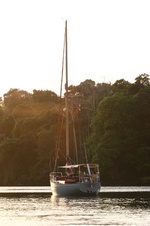 | 12.
Rio Chagres (February 2007)| The Chagres was a short hop round from the hussle and bussle of Panama. It is a stunningly beautiful rain-forest river and here we enjoyed a few days peace and quiet where we gathered ourselves amidst the preparations for our Canal transit. Each day we awoke to the sounds of parrots and toucans screeching overhead. From here it was back to Colon, Panama and the long-awaited Panama Canal transit. |
| 6471 Visits
19 Images
Shared Album | |
|
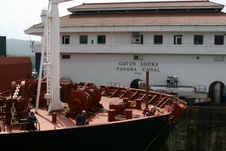 | 13.
Panama (February 2007)All good things must come to an end and the Panama Canal and the Pacific beckon so we enjoyed a good sail from the San Blas to Isla Linton (where we were almost attacked by monkeys ashore) and thence to Portobello, main hub of the transportation of treasure from the Spanish Main and so attacked by Drake, Henry Morgan and Adm Vernon among others. Here we saw lovely old forts in various states of disrepair but with all their original cannon.
The Panama canal was a 20 mile motoring job from Portobello, and here we prepare for our transit through one of the engineering marvels of the world in the building of which 20,000 died of malaria and yellow fever. Stanley, our ship-agent, has taken care of the reams of paperwork and hours of offialdom required to transit the canal allowing me to finally bring the website up to date! We transit the Canal on Monday 26 Feb, a real milestone date in our cruise so far. We lock up through the Gatun locks, spend the night in the Gatun lake, make our way across 30 miles of lake to the Miraflores locks where we lock down in the morning of the 27th. See the Miraflores webcam here. |
| 19863 Visits
41 Images
Shared Album | |
|
 | 14.
San Blas 2 (January - February 2007)From Carti we went to the amazing island of Acuadup. This is a smallish, inhabited island that few yachts seem to visit, being off the beaten track. (Yachts are the only viable way of seeing the San Blas). We were befriended by two families who took us to their grass huts ashore (once we'd obtained permission from the island's chief of course) and fed us. We in turn fixed 2 small kids bikes and an outboard motor. We'd often hear a thump on the side of the hull and a cry of 'hola' and we'd have an 'ulu' (dugout) alongside, with an inquisitive family out for a stroll (they go everywhere in their canoes) to have a look at us!
During our time in the San Blas we were visited many times by Kunas selling molas, local fruit and veg, bread that went mouldy after 24 hours but was gorgeous fresh, fish and lobsters. The boys were very popular, and spent hours ashore running around or playing football but Rebecca was the real hit, everyone tried to pick her up, kiss her, tweak her cheeks etc – she did not always enjoy the attention!
The San Blas has been the high point, for me, of our travels so far and I feel privileged to have seen them. |
| 28769 Visits
58 Images
Shared Album | |
|
 | 15.
San Blas 1 (January 2007)The sail from Colombia was good, lightish winds and a lumpy sea made it uncomfortable at times but we made good time and were rewarded with our first views of the San Blas at around lunchtime. And what views! The San Blas islands are home to the Kuna Indians; you'd be forgiven for not having heard of them, being a small group of islands belonging to the Rep of Panama, but nevertheless the Kunas are fiercely independent and shunning the western way of life.
The islands are small (often football-field size), made of sand, crammed with tall, swaying palm trees and set in azur water behind a barrier reef that prevents them being washed away. On some of these islands live the indians, in grass huts in clearings in the trees. Most of the islands do not have fresh water or electricity; all water and food is brought in by ulus which are hand-hewn dugout canoes. These indians are some of the last 'unspoilt' people on earth and their happiness despite their poverty (they are poor, but only materially) has to be seen to be believed. It is very humbling. They live by fishing, and tending 'farm' patches on the nearby mainland that they reach by dugout, generally sailing one way (their sails are made from any fabric they can find so are often a riot of colour) and paddling back against the onshore trade winds. Coconuts grow in abundance on the islands and they are collected and sold by the Kunas; us ‘gringos’ are not allowed to take them.
Our clockwise circular route round the western San Blas started at the Cocobanderos (uninhabited, idyllic), Green Island (local Croc, uninhabited, idyllic), Maquina (small, inhabited, pretty) and the Islas Carti (densely populated, dirty). |
| 18101 Visits
92 Images
Shared Album | |
|
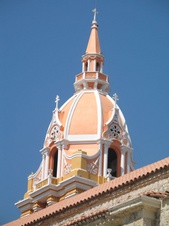 | 16.
Colombia, Cartagena (December 2006 - January 2007)The sail to Colombia has a fearsome reputation; strong winds and disproportionately steep seas. Many boats sustain damage on this trip, we were OK but glad to get to Cartagena. On the way we saw something of the coast; Five Bays was beautiful. Rodadero was pleasant although it was here that our dinghy and outboard were stolen.
Cartagena, where we stopped over the festive period, was a beautiful and ideal place to be at this time of year. The old town was clean, safe and very pretty with good eating out at very low prices. Highlights included a mud volcano, which was hundreds of feet deep but with the mud so deep that you could not sink if you tried, and having plenty of kids around for our crew to play with. Colombia has an unenviable reputation, but it has been our favourite country to date with the most pleasant people. Go if you get the chance! |
| 11394 Visits
128 Images
Gallery Album | |
|
 | 17.
Bonaire diving (September 2006)| Bonaire is one of the best dive sites in the world; clear warm water and undemanding, easily accessible sites make it ideal for relaxing dives. For me it was great! There were plenty of other boats with keen divers on board, so I dived twice a day every day from different locations along the shore. The diving was superb, beautiful coral, some good fish life and plenty of variety in dive sites. The Hilma Hooker was a great wreck dive. Most days I dived to 100 feet and slowly back to 10m whilst swimming along the reef and back; the afternoons dives were shallower. Airfills were cheap and easy. These pictures are all taken by Murray, a good friend from Decourcy Spirit; the results from his camera are far superior to those from mine! He also takes credit for the video clip. |
| 9049 Visits
66 Images
Shared Album | |
|
 | 18.
The ABCs (September 2006 - November 2006)The three islands of (from E to W) Bonaire, Curacao and Aruba make up the Dutch islands known as the ABCs. Bonaire was superb; here we saw our first wild flamingos, got used to decent supermarkets and good food ashore, made new friends and Gerard did dozens of dives in this world-class diving area. Our 10 days or so in Bonaire went way too fast but we enjoyed a cracking sail to Curacao.
Curacao was OK, the anchorage in Spanish Water was very protected and a great place to leave the boat for 3 weeks whilst we took time out to fly home and see our respective families. After a cruise up and down the west coast of Curacao with our now long-time friends on Iceni it was time to make the fearsome journey to Cartagena. But before that sad goodbyes to the Icenis who have gone north.
Aruba was rubbish; expensive, windy and unfriendly so we were pleased only to be passing through! |
| 7508 Visits
68 Images
Shared Album | |
|
 | 19.
Offshore Islands (August / September 2006)| From PLC we sailed to Tortuga, Los Roques, Los Aves and then on to the Dutch Antilles. The Offshore islands of Venezuela are generally uninhabited, low lying and very beautiful. Most anchorages are protected by coral reefs so navigation is undertaken with care, with the sun overhead or behind; coral is beautiful but entirely unforgiving. |
| 5683 Visits
40 Images
Shared Album | |
|
 | 20.
Orinoco flow (August 2006)| After a long trek back from the Gran Sabanna we stopped off at a ramshackle camp to take a tour of part of the Orinoco delta. The Orinoco is the 8th largest river in the world, and the delta is inhabited by the Warao Indians who live on simple wooden and thatch structures at the waters’ edge. They live a simple subsistence life, nicking electricity for their satellite TVs (their one luxury, often shared) from the local mains wire. Our trip on the delta was interesting for the wildlife and the Indians, but a day does not do it justice and I’d like to spend more time here. |
| 8880 Visits
63 Images
Shared Album | |
|
 | 21.
Inland Venezuela - we go on tour! (August 2006)| The main reason for going to PLC (as Puerto La Cruz is widely referred to) was to take a tour inland and so it was that, with our good friends from the Dutch boat Orion, we hired an old Toyota Land Cruiser and a driver called J-P for the princely sum of USD35 per day (about £18) and we took a 10 day tour inland visiting the Gran Sabana region, an area of barren, open land with massive ‘Tepuy’s (a Tepuy is a small table-land) across the landscape. We camped in tents pitched under thatched ‘Churuata’ belonging to the local Indians amidst breathtaking scenery, all so incredibly different to life on Clarabella. We walked, talked, drove, climbed, swam and were eaten alive by industrial-strength mosquitoes in the most beautiful settings. We made our way back to PLC via the mighty Orinoco River, a river I’ve always wanted to see since the Wombles hit kids’ TV show in the 70s! |
| 7073 Visits
74 Images
Shared Album | |
|
 | 22.
Venezuela - en route (July / August 2006)| Venezuela: now the fun starts! Any yachtsman who’s dreamed of venturing away from England’s green and pleasant land will have heard of Venezuela’s reputation for piracy, theft and general mayhem. As we progressed further down the benign Leeward and Windward islands we were increasingly asked were we going to Venezuela, if so were we going with a ‘buddy’, were we armed, would we lock ourselves in at night etc but as is so often the case all the hype is generated by those who have the least experience and so after a lovely sail from Trinidad to Los Testigos – a dry and rocky set if islets belonging to Venezuela, about 100 miles off the mainland coast and inhabited by a handful of subsistence-living fishermen – we could not have had a warmer welcome from the teenage-looking guarda costa who ‘protect’ this guano strewn archipelago from all comers. After a cursory glance at our papers he emerged from a back room with a glass of iced tea and we chatted for the next ½ hour about life. The Testigos were beautiful, very peaceful after the bussle of Trinidad and we had the feeling for the first time of really going off the beaten track. From there we sailed to Margarita, the main Venezuelan holiday isle, home of exceptionally cheap duty free booze (and thus home to a fair few dipso-liveaboards) where we rolled in Porlamar before heading off down to Puerto La Cruz, the centre of yachting in Venezuela. |
| 3357 Visits
17 Images
Shared Album | |
|
 | 23.
Trinidad 2 (July 2006)| We also went to see the (apparently) world famous pitch lake from which (again apparently) the majority of the world’s road are surfaced, the Asa Wright Nature Park where we saw a huge variety of beautifully coloured birds in a lovely rainforest environment as well as touring to the Caroni Swamp to see the Scarlet Ibis flying home to roost. My brother Ben was also in Trinidad on his boat Midnight for a while, so Clarabella and Midnight were alongside each other after 8000 miles of sailing apiece. The cruising around Trinidad took us to Scotland Bay and Chacachacare Bay, both beautiful lush green bays in which we could hear the howler monkeys in the trees as we watched green parrots flying overhead. We very much enjoyed Trinidad! |
| 5527 Visits
55 Images
Shared Album | |
|
 | 24.
Trinidad 1 (July 2006)| Trinidad turned out to be one of our longer stops this year; we’re now south of the hurricane belt and so out of harm’s way. Trinidad boasts the best boating facilities in terms of storage and repair in the Caribbean and so whilst we attended to numerous outstanding issues with the boat we took time out to enjoy my birthday with our friend John over from the UK to supervise work to his boat (Stromboli) and with car hire for 12 USD a day it would have been rude not to see something of the island, especially as the wildlife on Trinidad is amazing. So we took tours to the Nariva Swamp to see parrots, macaws and monkeys, and to the north of the island to see the endangered leather-back turtles emerging from the sea on a bright moonlit night to lay their eggs, a sight that will stay with us all for a long time. |
| 6447 Visits
58 Images
Shared Album | |
|
 | 25.
Grenada (June 2006)| A superb sail from Carriacou took us to Grenada, the island that was devastated by Hurricane Ivan in 2004. Here we spent a couple of weeks in St Georges relaxing, and during this time I completed my Advanced Open Water Diver course. There are some spectacular wreck dives off Grenada as well as some beautiful scenery inland. We teamed up with Iceni to do a day's tour inland seeing abandoned aircraft at a disused airfield, the solar powered Grenada Chocolate Factory and a Rum distillery. We also spent a week ashore at Spice Island Marine for a much-needed anti-foul and topsides polish. This yard took a direct hit in Ivan, and hundreds of boats were destryed in this yard! As it is now hurricane season we were not sorry to leave and sail overnight to Trinidad. |
| 8502 Visits
46 Images
Shared Album | |
|
 | 26.
The Tobago Cays (May 2006)The Tobago Cays are without doubt the most beautiful part of the Caribbean – provided the trades are not blowing strongly. We were very lucky in this respect and enjoyed a memorable time amidst impossibly blue water, the best snorkelling and good walks ashore. The Cays (pronounced ‘keys’) are a group of very small islands protected by barrier coral reef, which protects the anchorages. The snorkelling, particularly on the seaward side of the reef is stunning. Visibility is 100ft + with marine life, on the wall of the reef, plentiful and varied. Here we first saw Eagle rays and Sting rays. Off the boat we watched turtles feeding, and they were happy enough to have us snorkelling above them, only a few feet away. Monica was doing just this when she suddenly shot back into the dinghy: she had had a close encounter with a 6ft nurse shark! I, of course, went into the water immediately, but the thing had swum off! Boat boys kept us in basic supplies and we spent a very happy time here.
From the Cays we hopped south out of the path of potential hurricanes, stopping at Mayreau again then to Union island where I collected my dive gear – in the town called Clifton! - and helped a customs chap not charge me any duty…! Then we spent a a night or two at Petit Martinique and Petit St Vincent, both fairly unremarkable despite friendly locals before leaving the Genadines for Carriacou, officially part of Grenada. |
| 7163 Visits
33 Images
Shared Album | |
|
 | 27.
St Vincent & the Grenadines (May 2006)The islands below St Lucia and above Carriacou form the country of St Vincent and the Grenadines. We spent some weeks in this chain, starting at St Vincent. We did not particularly enjoy the island, despite it being home to some beautiful scenery as well as the film set of Pirates of the Caribbean. St Vincent has an ugly reputation for crime against yachties as well as being one of the world’s major centres for the production of marijuana. Wherever we went we were plagued by pushy boat-boys, some of whom had clearly been sampling the local home-grown produce or worse.
We enjoyed seeing the film set of Pirates of the Caribbean in Walilibou bay (Keira was absent sadly), where we went after the very beautiful Chateau Belair and Cumberland Bay. Before leaving St Vincent we took a tour up the island to see the extremely beautiful Montreal Gardens, full of lovely tropical flowers, plants and fruit trees.
In Bequia we stopped for a week or so, during which I did the first of my dive courses, qualifying as an open water diver. This included a number of absolutely stunning dive over pristine coral populated by riotously colourful reef fish. I even saw a seahorse! Tom didn’t want to be left out so he had a trial dive in Bequia too, although he’s too young!
From Bequia we had a lovely sail to Canouan (not very pleasant) and to Mayreau. Mayreau’s a very small island with an archetypal Caribbean anchorage at Saltwhistle Bay, a tiny church, a school and terrific views over to our next stop, the Tobago Cays. [Please see separate Gallery] |
| 1425 Visits
66 Images
Shared Album | |
|
 | 28.
Dominica and St Lucia (April and May 2006)Dominica was our next island on the way south. We had really enjoyed being near Roseau, the capital, on our way up and although it failed to reproduce its charm to the same extent the second time around – mainly because we anchored off and Oh how we rolled… - we nevertheless had a great time doing another tour to a part of the island that had not yet explored. Here we also met up with Iceni again, a Warrior 40 whom we first met all those months ago in Spain and with whom we crossed the Atlantic in radio contact.
We passed down the west coast of Martinique promptly as we had covered this region fairly fully on our way up (we did ‘pull in’ to stock up on French comestibles, notably bread and croissants!) and headed back to St Lucia, our point of arrival in the Caribbean. It was good to be back, people remembered us – they would with 5 of us on what is in Caribbean terms a very small boat – and we enjoyed seeing more of the island. After a pause for thought in Rodney Bay we headed down the island towards Marigot Bay. I had been looking forward to Marigot for months; it is billed in the pilots as ‘idyllic’ and the ‘epitome of a Caribbean hideaway’ etc; we arrived there to find the ‘charming’ bay was in fact lined by a very unpleasant building site, noise, and a charter boat company. We nevertheless gritted our teeth as the 35 knot squalls ripped through the anchorage and went ashore for supper. Whilst ashore, and the supper was truly excellent, the little bay filled up – literally – with many dozens of charter boats who had just collected their charges. Suffice it say that we were literally and figuratively fending off complete landlubbers in charge of huge catamarans who had not the faintest clue how to anchor. After dark they got to grips with their barbecues whilst bumping into one another and competing to see who could play the loudest music. I have a lovely memory of one idiot trying to light his gas barbecue by pouring outboard fuel into it and gingerly offering it a lighted match. I particularly enjoyed seeing the results in daylight!
So we moved off down the coast to the Pitons, two very tall, steep peaks formed by volcanic activity and offering lovely anchorages. The first of which was 2 boat lengths off a sheer cliff in which a narrow cave housed a colony of bats; I managed to snap a few with the camera and flash as they sped by the boat looking for insects. We enjoyed some beautiful sunsets here, swimming and snorkelling from the boat and we took a tour inland to see the sulphur springs. A word about tours: You can pay about US$100 for a pretty basic private tour in a minivan with a surly driver or you can DIY by taking a local bus (also a minivan, but usually in a poor state of repair apart from the stereo which always works exceptionally well) for EC$3 (about 60p). Guess which we did! |
| 7880 Visits
38 Images
Shared Album | |
|
 | 29.
Isles de Saintes (April 2006)| On our way north we briefly passed through the island group called the Saintes, and we were pleased to be able to spend longer there on the way south. It is a beautiful area of quiet tropical anchorages served by a pretty village, surrounded by good walks. One of these took us up to the Fort Napoleon, where we encountered our first iguanas at close quarters! We also had Easter here; it seems that the UK is the only place on earth that sells Easter eggs so we were very lucky to find ‘kinder eggs’ for the kids but we had anyway painted our own eggs and made decorations for the boat. |
| 5646 Visits
47 Images
Shared Album | |
|
 | 30.
Guadeloupe again (April 2006)| After an unpleasant 14 hour slog, during which our watermaker pump broke down again, we made Deshaies on Guadeloupe. This was a pretty bay with turtles swimming around and some pleasant walks ashore. It was a relief to get back to French bread and croissants etc after the muck which they call bread elsewhere in the Caribbean! Down the coast of Guadeloupe we stopped briefly to snorkel in the Jacques Cousteau National Park around Pigeon Island, a beautiful area of turquoise water, startling visibility underwater and exceptional marine life in the form of coral and tropical fish. |
| 3560 Visits
21 Images
Shared Album | |
|
 | 31.
St Kitts and Nevis (April 2006)We enjoyed Nevis; it is a quiet, civilised island that looks after its visitors well. We had a slowish sail over from the west coast of Antigua; Clarabella has been in the water for a year now and although I dive to remove barnacles, weed and other things that seem to like International’s antifouling paint I’m losing the battle. With a good breeze we can still notch up 6 knots – I suppose the barnacles pull themselves in or something – but in lighter winds we slow right down. Anyway, we reached Charlestown, dropped the hook and went ashore the following morning to clear customs. Normally this is a fairly painless affair but here I had to fill in a form with boat details, crew list (passport number, full names, dates of birth etc for all 5 of us) at customs, do the same at Immigration (at the local police station, where they write up the names of banned drivers on a black board under a heading that says ‘Jesus saves’) and then similar at the port authority. I often give spoof addresses on these forms in the certain knowledge that they are never read!
The Golden Rock plantation was a genteel place where we walked in the morning, swam in the pool, saw lots of the local monkeys, had a good lunch, swam again and made our way back to the boat. On St Kitts a bus driver – don’t forget that the buses here are all minivans packed to the gunwhales with people, reggae music at full volume driven at high speed – took us all the way up the hill (with a little financial persuasion for the driver to deviate from his route) to Brimstone fort, a lovely place to spend a few hours in the presence of a little history.
From St Kitt’s – where we languished for a week whilst waiting for a battery charger to arrive to replace the failed one – we sailed back to Nevis, disposing of Rebecca’s now-defunct pushchair en-route, much to the delight of the kids! Back at Nevis we stayed at the very beautiful and peaceful Pinney’s beach, home only to pelican’s that dive for fish from a great height, not worrying at all about how close we might be swimming to their fishy meal.
St Kitt’s was our turning point; the hurricane season gets going in the summer and our insurance company insists that we are below 12 degrees North (St Kitts is at 17.3 deg N) by the beginning of June, and we still have a lot to see and do!
We left Nevis at dawn, aiming for Guadeloupe, 70 miles of up-wind slog away, but passing the tiny rock of Redonda, which is in fact a kingdom, and then sailing down the lee of Montserrat. You’ll recall that this island hit the headline in the 90’s when its volcano erupted, forcing the evacuation of the island. As we passed the volcano was pumping out dust almost to the edge of the mandatory exclusion zone and we could clearly see the ruined town of Plymouth, with many houses up to the eaves in ash. As I write – in late May – the volcano has again erupted a few days ago, sending lava flows 2 miles out to sea; exactly where we were a few weeks ago! |
| 5604 Visits
53 Images
Shared Album | |
|
 | 32.
Antigua (March 2006)Antigua is the centre of yachting – especially superyachting – in the Caribbean. We arrived into English Harbour on the south coast to meet up with friends, expecting to find ourselves in a tropical version of the Solent. Instead we found English Harbour very pleasant and civilised, and we appreciated the historical feel of the place. There’s plenty of good walking around the area and a favourite walk of ours was up and round the headlands from English Harbour to Falmouth Harbour through cacti, aloe plants, humming birds, many goats and amidst spectacular views to a small beach where the beach bar did excellent fruit smoothies! We also walked up to Shirley Heights for the weekly tourist bash, where loads of large Americans and sweaty Brits get bussed up, get drunk and get bussed back down. We arrived early enough to appreciate the spectacular views over English and Falmouth Harbours and to enjoy the excellent steel band – they call them steel orchestras over here – before wandering back down again.
Further round the spectacular south coast we met up with “Jemima”, another boat with kids on, with whom we spent a good couple of days cruising before we moved on northwest towards Nevis. |
| 4153 Visits
34 Images
Shared Album | |
|
 | 33.
Isles de Saintes and Guadeloupe (March 2006)The short trip between Dominica and the Isles de Saintes, which lie midway between Dominica and Guadeloupe, was a motoring job – for once – and allowed us to arrive with full water tanks and batteries fully charged. The Saintes are beautiful but we were only treated to a one night stop as they are exposed and the weather was not settled.
We had a good sail to Guadeloupe, a very French island, looking on a map much like a butterfly with spread wings. Here it rained a lot and the boys were unwell with a tummy bug. Long overdue haircuts were administered to the males! We hired a car to explore the interior of the island, much of which is beautiful rain forest.
One of the highlights of our stay in Guadeloupe was the trip up the Riviere Sallee, the shallow mangrove lined river that divides the two halves of the island. The road bridges lift once daily – at 0500! The trip between the two bridges takes place in total darkness; the remainder of the trip can be done at much more sociable hour.
We will be visiting the prettier anchorages in Guadeloupe and the Saintes on our way back down the chain – more photos then! |
| 4644 Visits
31 Images
Shared Album | |
|
 | 34.
Dominica 2 (March 2006)The two main anchorages in Dominica are Roseau, in the south, and Portsmouth in the north. After Roseau we moved up to Portsmouth, where we took an early morning river trip into the Indian River, a peaceful mangrove lined river, which, apparently, has been used in Pirates of the Caribbean II (whatever that is!).
The shoreline in Portsmouth is littered with wrecked freighters that went ashore many years ago in a hurricane and for which the resources do not exist to remove them. |
| 2746 Visits
12 Images
Shared Album | |
|
 | 35.
Dominica - Carnival (February 2006)| Carnival took place over two days, during which the island goes into party mode. The majority of these pictures were taken at 8am on the first morning of the carnival, by which time many people had been up all night and for a variety of reasons were the worse for wear...! Lively costumes were worn for the parade later in the day. Although we never felt threatened at any stage the carnival ended on a sour note with the fatal stabbing of a teenage boy. |
| 5143 Visits
31 Images
Shared Album | |
|
 | 36.
Dominica (February 2006)| Dominica could not be more different from Martinique. It is one of the poorer islands and lacks the chic charm of the smarter Martinique towns. It more than makes up for it in beauty. We are currently anchored south of Roseau, the capital town, and made it here in time for the carnival. We're anchored in crystal clear water, with the stern tied to a palm tree! Diving over the side of the boat we are greeted with the sight of coral and reef fish. Turtles have been spotted next to the boat! It is hot, but not awfully so, and the evenings are warm but not stifling. Tours are not expensive so we have been on a snorkelling tour to see coral reef and to 'Champagne', an area off the beach where volcanic activity makes millions of tiny bubbles emerge from the surrounding reef. We have been round the island seeing waterfalls and the indigenous (sp?) Carib Indians. Yesterday we walked in to a beautiful waterfall, but overnight rain made the walk in extremely tough indeed as we had to cross the river a number of times. We moved on to the anchorage off Portsmouth in the north of the island, which was remarkable only for the amount of rolling that we did during the night! |
| 7185 Visits
71 Images
Shared Album | |
|
 | 37.
Martinique (Febryary 2006)| After spending a couple of weeks in St Lucia sorting ourselves out, enjoying being back in touch with the real world and getting to grips with Caribbean food and drink we moved on to Martinique, the island immediately to the north. We arrived at Marin (in the south) after a very breezy sail over. We spent a few days in Marin and St Anne, where we celebrated Monica's 40th, before moving north to snorkelling waters at Anse D'Arlet, Anse Noire and St Pierre. Marinique is a nice enough French owned island (croissants and pain au chocolat were a welcome start to the day) where a lot of building is taking place thanks to European money!! St Pierre was an interesting place, having been totally obliterated by a volcanic eruption from Mt Pelee in 1902. |
| 6333 Visits
34 Images
Shared Album | |
|
 | 38.
St Lucia, West Indies (February 2006)We are enjoying our stay in Rodney Bay Marina, St Lucia. The laundry ladies have been inundated with over a month's worth of laundry and we have access to mains electricity, water, internet, decent food shops etc after more than a month without. The boys enjoy the beaches and Marina pool; we enjoy sundowners with friends from other boats.
Minor repairs to the boat are on-going, the shroud that started to fail in the Atlantic is being repaired.
We have heard that one of the other Blue Water Rally boats has been lost on a reef; the crew are ok. |
| 3550 Visits
6 Images
Shared Album | |
|
 | 39.
The Atlantic Crossing (January 2006)We sailed over 2100 nautical miles (over 2500 land miles) in two weeks and one day, an average of nearly 6 knots. We had a tough time, with strong winds, large seas and some gear problems; there were very few days when photography was possible owing to spray and salt in the air (as well as in the cabin at times...). Monica and the children were great, as was Clarabella.
INCLUDES a bit of video that I took, on a digital stills camera, on a 'quiet' Atlantic day. For the most part photography of any description was just not an option on the crossing :-( |
| 5196 Visits
32 Images
Shared Album | |
|
 | 40.
Sao Antao (January 2006)| We took the local ferry to the neighbouring island of Sao Antao. After a great deal of haggling we secured the services of a driver and van (although he still picked up so many other passengers that the van was full to overflowing) and off we went round the island for the day. Lots of sights, sounds, smells, poverty but fundamentally happy people. Not at all geared for tourism, which was a nice change. |
| 9375 Visits
36 Images
Shared Album | |
|
 | 41.
Sao Vincente, Cape Verde Islands (January 2006)After 6 days at sea and a fast trip down from the Canaries we arrived in the Cape Verde Islands, our first 'tropical islands'! These are a very poor set of islands, well out into the Atlantic, mostly supported by subsidies from the EU and the USA. *** UPDATED Feb 5 ***
We stopped in Mindelo, Sao Vincente. The anchorage was secure, which was just as well because we had terrific winds over the anchorage, and boat was absolutely covered in orange dust from the Sahara.
Do have a look at the Sao Antao album too... |
| 5637 Visits
29 Images
Shared Album | |
|
 | 42.
San Sebastian, La Gomera (December 2005)This small island is off the SW tip of Tenerife. We spent about 10 days there over Christmas. It's a pretty island and the town by the marina is very pleasant. Car hire was cheap and we spent a day exploring the island.
We enjoyed our first Christmas afloat too, and on the the 27 December we left for the 800 mile trip to the Cape Verdes. |
| 3635 Visits
20 Images
Shared Album | |
|
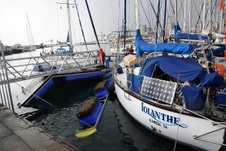 | 43.
Tenerife again (Novemeber 2005)| Here we are again in Tenerife waiting for repairs to the boat and parts for equipment. A lashing from the weather stick has made life a little more interesting! |
| 3566 Visits
16 Images
Shared Album | |
|
 | 44.
The Atlantic - Take 1 (November 2005)| 10 days at sea, 1000 miles covered. All for nothing; equipment failure and a tropical storm forced a return to Tenerife. |
| 4661 Visits
30 Images
Shared Album | |
|
 | 45.
Tenerife (November 2005)| Some pictures taken during our (first) stay in Tenerife. |
| 3337 Visits
15 Images
Shared Album | |
|
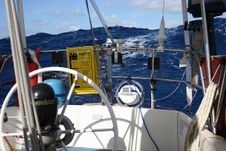 | 46.
Gib to Tenerife (Novemeber 2005)| 6 days at sea took us from Gib to Tenerife, with weather from flat calm to a two-day gale from astern. Some great sailing, and our confidence in the boat has grown hugely. |
| 3355 Visits
10 Images
Shared Album | |
|
 | | 47.
In Gibraltar (October 2005) | 3171 Visits
27 Images
Shared Album | |
|
 | 48.
A weekend in Morocco (October 2005)The Rally fleet sailed to Smir, 30 miles away, in Morocco for an overnight stay. There we were met by a camel outside customs clearance (!). Later a coach trip left for the old 'medina' or walled market in Tetouan, a city of 600,000 people; what a fantastic place! Supper was taken in the medina after a long walking tour.
The following day the fleet had a great sail to windward in a force 6 back to Gib, a superb way to clear the cobwebs! |
| 8284 Visits
48 Images
Shared Album | |
|
 |
|
 | 50.
England to Spain (July and August 2005)| The first gallery of pictures from our trip starting in Bristol and taking us to Spain so far. |
| 3282 Visits
77 Images
Shared Album | |
| |
| | 51.
Video Clips (October 16, 2005) | 1 Albums
Shared Folder | |
| |
|
|
 | | |